by Chuck Cornell
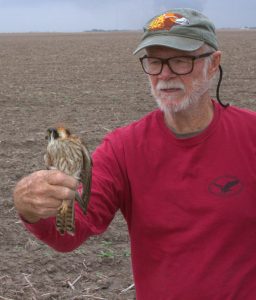
In 2015, my friend, Gus Rentfro, mentioned that he knew a guy who banded raptors. “Would you like to go out with us some time?” he asked. “Yes” was my reply and thus began my adventures with Bill Clark and raptor banding.
On the first outing, I drove my car and followed Bill and Gus out to Hwy 4 near Boca Chica. Using walkie talkies to communicate, we drove until they spotted a hawk perching. While I parked on the shoulder, they would drive past the hawk, do a U-turn, and drop traps on the side of the road opposite the hawk. Upon returning to where I was, we wouldwatch the traps. The first hawk was really responsive. It was down on the trap in a flash and was caught. I was hooked! On this day, we got four Harris’s Hawks and one American Kestrel. Altogether a wonderful day.
Since that day, I have become a helper to Bill and have learned a lot. In fact, I learn something every time I go and now feel fairly confident when making an ID of a hawk be it a juvenile or an adult. Bill is a patient teacher and allows you to learn at your own pace and within your comfort level. During the first few outings with him, my main tasks were to watch for hawks as he drove and straightening out the nooses on the traps after we caught a bird.
Whenever I talk about banding raptors one of the first questions is “What kind of traps are used to catch the birds?” The traps that Bill mainly uses are call Bal-chatri or BC traps. They are based on the traps first used in India for falconry. India has had falconry for at least 600 years and somewhere in that time frame the Bal-chatri trap was developed in order to capture hawks. The original trap was a cage made from cane and on top were horsehair nooses. Mice or birds were placed inside the cage and when the hawk tried to get the critter their toes would become ensnared in the nooses.
Today’s traps work the same way, but they are usually made from hardware cloth and the nooses are monofilament. Bill usually packs three to five traps in the car and they are baited with a variety of lures to be attractive to the variety of raptors we have here in south Texas. Lures are the term used instead of bait because they are not killed (usually) during the capture.
Lures used are mice, gerbils, house sparrows, collared doves, and pigeons. Usually there will be one or two traps with a sparrow/mouse combination. The sparrow keeps the mouse moving and movement is what attracts the birds. Doves or pigeons are solitary and have their own style of trap. Gerbils are generally in pairs although they can be in with a sparrow as well. Two mice together is another common combination.
The Bal-chatri traps are weighted with a dumbbell so that the bigger birds don’t fly away with them. Kestrels are too small and light to fly with the traps so they don’t need weights on them.
The three most common styles of trap Bill uses are square shallow traps, a dome, and what he calls Quonset hut which are oblong traps with a curved top. In the United States only those who are permitted through a trapping permit, banding permit, or falconry permit may trap a raptor.
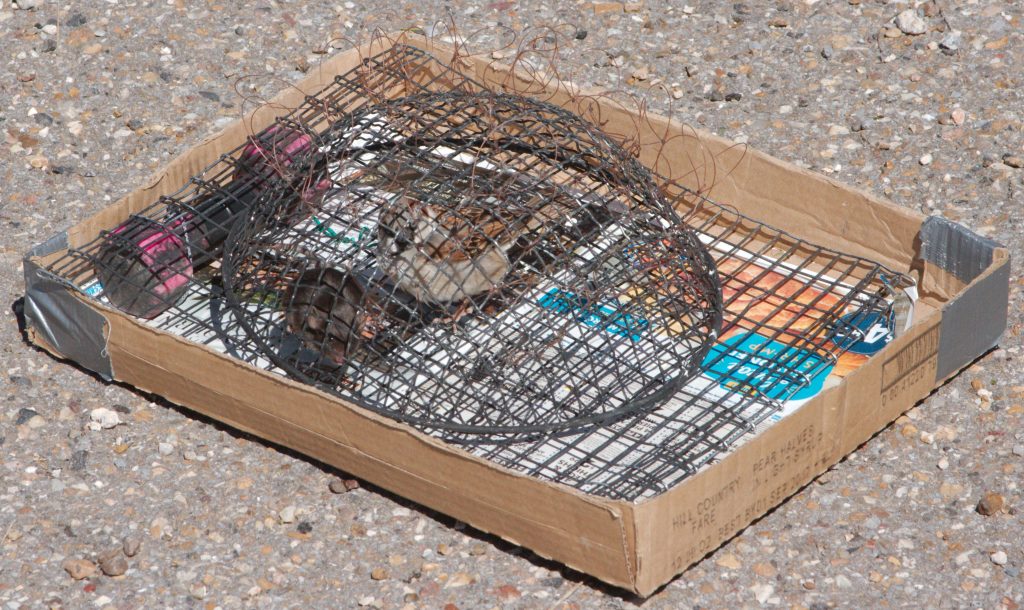
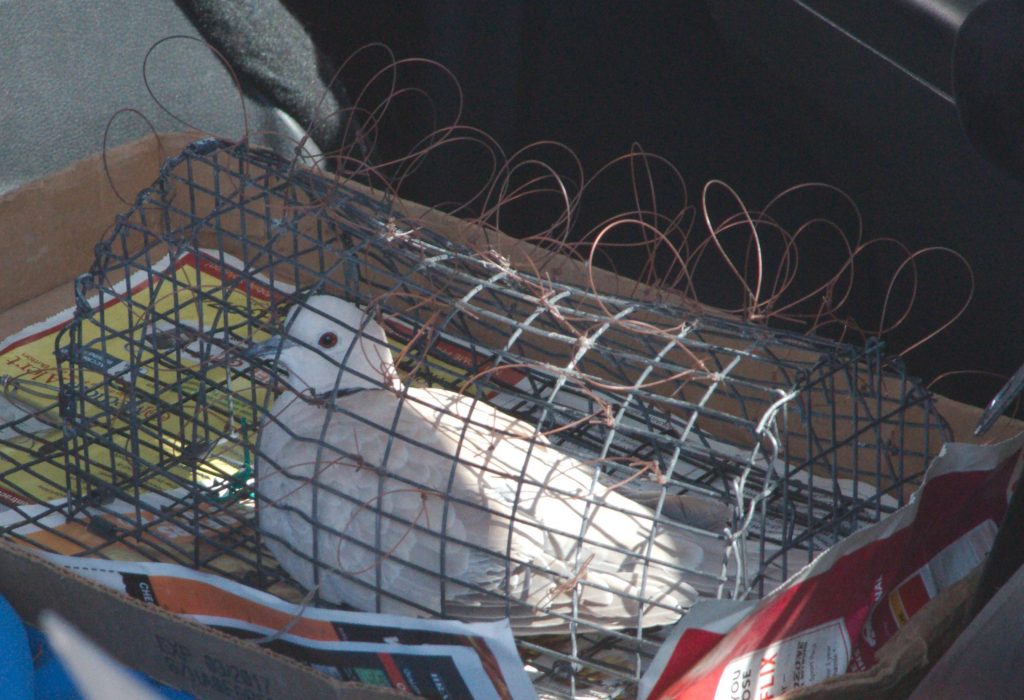
Another trap I’ve seen used is a bow net. Bill has one that at this time is used exclusively for Kestrels. It has a small wire box that holds the lure and a net that when tripped will cover that bird and hold it until it’s retrieved. These work amazingly well and are quick. The trap operates with a set of springs; the bird trips the trap when it hits the wire cage. Healso has a bow net that is triggered manually with a tug of a rope. These require more of a setup as opposed to the easily used Bal-chatri traps which are simply tossed out the window of a moving car.
The way we most often do banding is road trapping. This is simply driving through an area and looking for raptors perched in trees or telephone poles along the roadside. Bill is exceptional at spotting birds and he is usually correct in his ID at a long distance. He will usually stop back a ways and check the bird with binoculars to confirm what it is. He will then call out what traps he wants to use. “Give me two mice and the sparrow/mouse” and I will reach into the back seat and grab the requested traps.
Depending in which side of the road the bird is on will determine where the traps go. The traps are placed opposite the bird so that they don’t see them being placed on the ground. Usually if it’s on my side I will open the door and toss them out. Tossing from a lower height gives a better chance that they will land upright, although that’s not always the case sincethe traps are tossed as the car is moving. We then drive a short distance and U-turn again to watch the hawk.
If it’s hungry and eager they will already be at the trap and caught by the time we turn around. This is of course the textbook situation, it doesn’t always go that way. We have sat as long as a half an hour waiting for the bird to come down. Sometimes they will come down, land, and just stare at the trap. Other times they will hover over it and maybe land or maybe just make a pass and go back up to the wire. Birds that have already been banded will no longer go after the trap. They have a long memory about the experience. On rare occasions we have caught banded birds but usually they were birds that were banded as chicks and as such were banded in the nest and have no memory of traps.
The majority of hawks we capture and band are Harris’s, American Kestrels, Gray, Red-tailed, and White-tailed. Other raptors caught include Merlin, Red-shouldered, Cooper’s, and Swainson’s Hawks, and White-tailed Kites. Some we have unsuccessfully attempted are Roadside Hawk, Zone-tailed Hawk, and Common Black Hawk.
After the bird is caught we drive quickly to the trap to retrieve it before it becomes too stressed or drags the trap into traffic. I usually grab the bird and the trap while Bill pulls the car to the shoulder and opens the back. He then collects the remaining traps while I release the hawk from the nooses. The bird is then put into a can until we can move to a quiet area to process the bird.
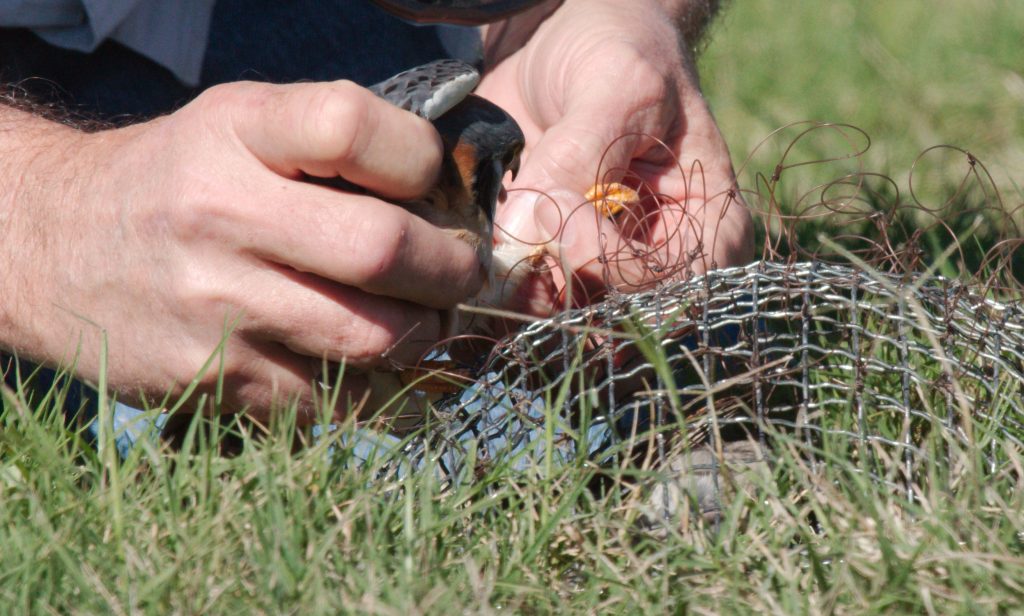
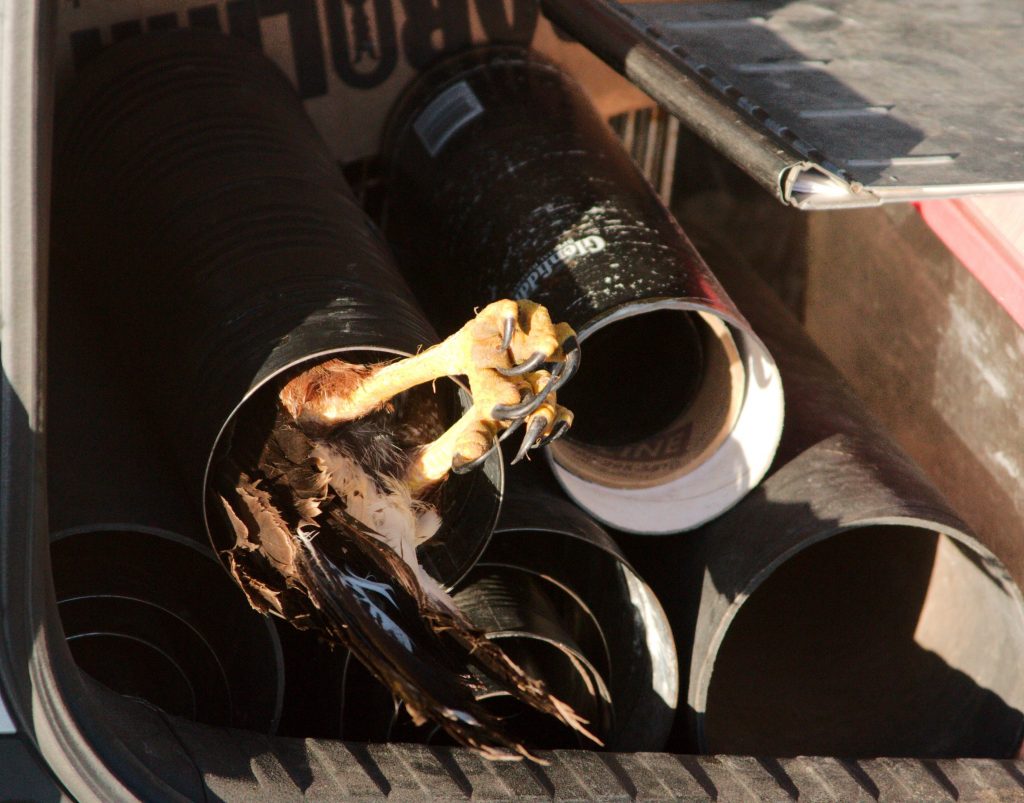
Once captured, the bird is quickly untangled and placed in a receptacle for processing
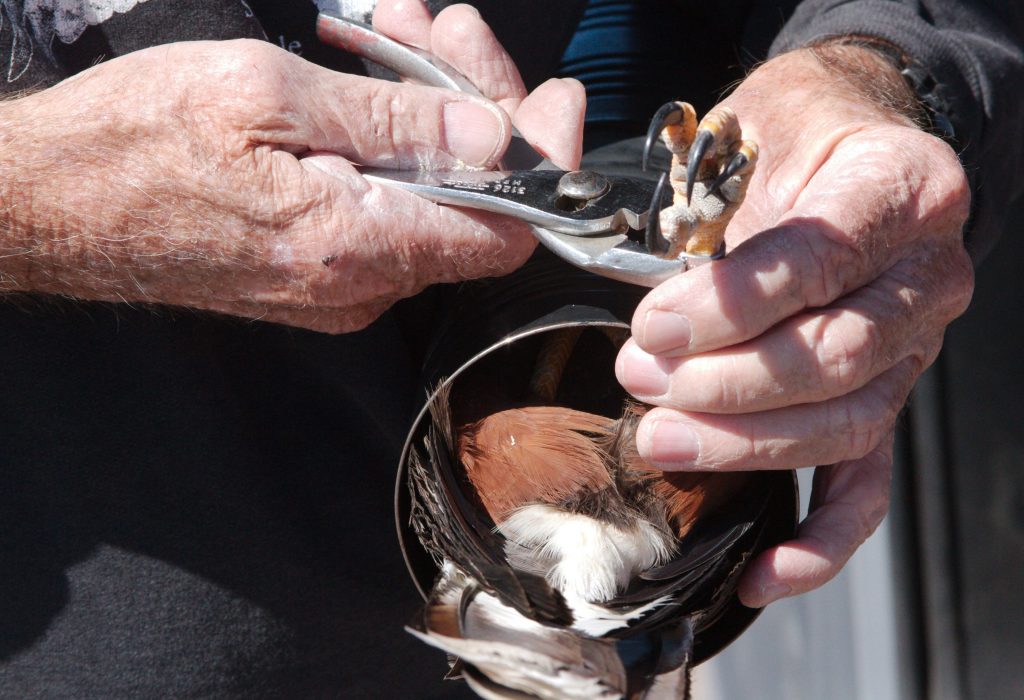
Bill handles all the banding processes and I take the trap and straighten out the nooses. The bird gets a silver band that is the official USGS Federal band. In addition, there may be a color band if the bird is to be part of a graduate student study.Color bands typically have either two digits or a digit and a letter. The codes are easy to read from a distance and with the different colors provide a positive identification.
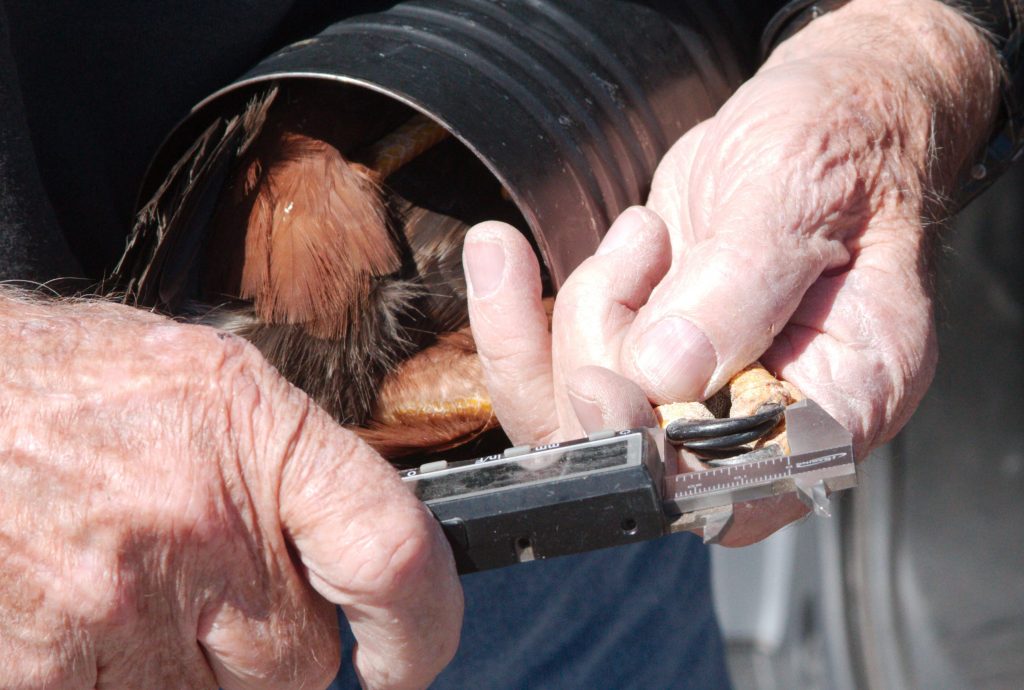
Record keeping is important. Bill records the band number andlocation of the bird when caught. He measures and records several identifying features on each bird using calipers and rulers. Measurements of the beak, talons, wing and tail lengths and other things that help determine the sex and age of the bird.
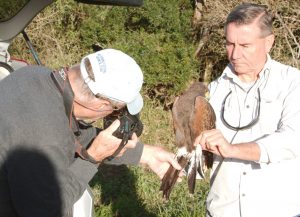
Several photos of the bird are taken to record details of the outstretched wings and tail. If it’s a color banded bird he will also take a photo of the color band with the numbers visible. If we have caught an unusual bird or there are other people along watching he will take a group photo with the bird or birds. The bird is then released to go about its business. The birds are not harmed in any way during the banding process. The only real downside for the bird is they don’t get the meal that they were hoping for.
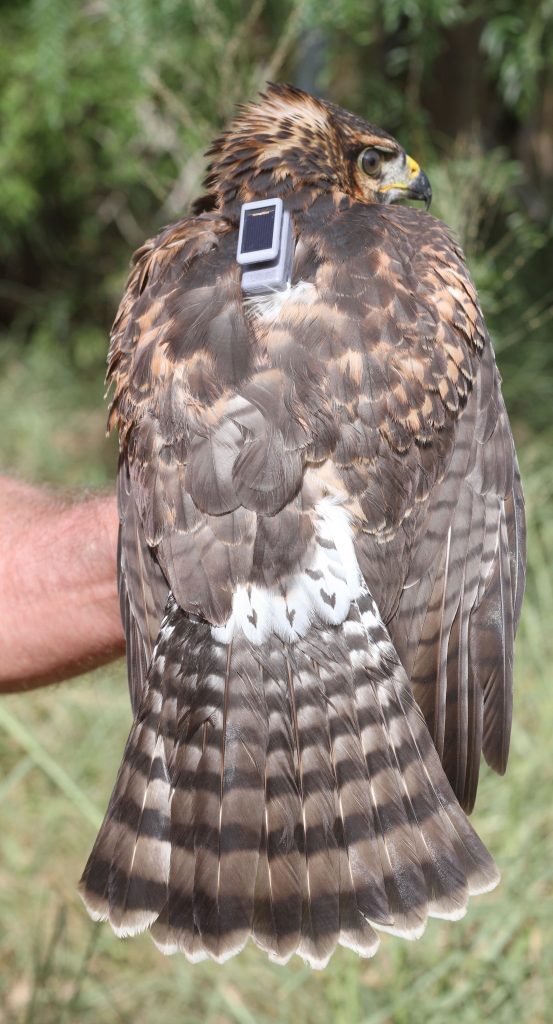
There are two other additions to the banding process, at times, to support graduate students’ projects. One is drawing blood from a vein on the underside of the wing for DNA tests. Another is to fasten a harness to them that holds either a VHF or GSM type transmitter. VHF transmitters are the cheaper of the two costing about $200 with a two-year battery life. They have a limited range and you must be nearby the bird in order to get a signal. GSM transmitters are up to 10 times the price of VHF, but last much longer. Some are solar poweredand can transmit data to a cell phone.
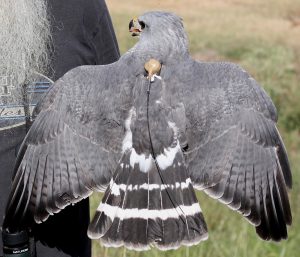
All in all my experience with Bill has been wonderful. I have learned so much and had such a good time in everything we have done. Sometimes other helpers or interested folks accompany us as we road trap. The car is small and full of traps and equipment so there is a maximum of two passengers. There are two other methods that are used to band hawks, but they deserve their own article. They are trapping in Sugar Cane fields and banding of chicks in the nest which doesn’t involve trapping. More later.
Thank you, Chuck! I thoroughly enjoyed this piece and learned a great deal!